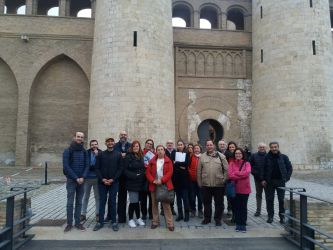The Spanish Diverfarming team assess their second year of work and outline the strategy of collaboration with farmers
As we reach the second anniversary of the start of the European Diverfarming project, which is led by the Universidad Politécnica de Cartagena and financed by the European Commission’s H2020 programme, the group of Spanish partners integrated within this consortium has held the second Annual Meeting of the South Mediterranean Region, coordinated by Beatriz Lozano, a researcher from the Department of Edaphology at the University of Cordoba.
 The meeting, which took place in the Zaragoza headquarters of the Consejo Superior de Investigaciones Científicas (CSIC), was inaugurated by the Director of the Aula Dei Experimental Station (EEAD - CSIC), Jesús Val, and the CSIC delegate for Aragon, María Jesús Lázaro, who assessed the work carried out in the project over the last 12 months.
The meeting, which took place in the Zaragoza headquarters of the Consejo Superior de Investigaciones Científicas (CSIC), was inaugurated by the Director of the Aula Dei Experimental Station (EEAD - CSIC), Jesús Val, and the CSIC delegate for Aragon, María Jesús Lázaro, who assessed the work carried out in the project over the last 12 months.
Important results can be extracted from this second year of the project, such as those obtained from case study number 16, in which different horticultural products are associated with legumes in an experimental plot in Murcia’s market garden, a zone suffering from agricultural and environmental issues.
In this case it is shown how both intercropping (combining two plants in the same row) as well as the 1:1 association (alternating rows of each crop) of melon and cowpea (a variety of bean) considerably increased the melon production, augmenting both in weight as well as in the number of fruits. Following techniques of reduced tilling, optimised fertilisation, integrated pest control and incorporation of green manure derived from crop residues it has been seen that the fixing of nitrogen to the soil also increases, since the legumes do that biologically, thus reducing the contributions of fertilisers. The fact that the cowpea flowering stage is immediately prior to that of the melon causes the pollinators to come to those flowers, facilitating the melon pollination.
Another of the milestones derived from this year and which open a road to sustainability for the agricultural community is the choice of a particular variety of lavender as a crop associated with the olive groves. After the researchers from the University of Jaen who work within the group formed by the UCO had studied the value chain of this product, they found high suitability with the traditional olive grove. This crop that grows in enclaves with a precipitation regime of up to 300 mm per year has as its final destination the not high-end perfumes and hygiene industry. Its inclusion in the alleys of the traditional olive grove would provide the farmer with a second income, benefits from agricultural policies in the event that it is considered vegetation cover, and a revaluing of these olive groves, which are currently fighting to be sustainable versus intensive and highly mechanised groves. The first technical trials are being undertaken now in the experimental olive grove that the project has in Torredelcampo (Jaen).
During the day, there was also a presentation of the machinery prototype that will combine different functions that each crop needs during its life cycle. For their part, the communication team, led by the Unit for Scientific Culture at the University of Cordoba, presented the strategy for the creation of the ‘Communities of practitioners’ which will be the communities of farmers who put into practice the diversification in their farms with the help and technical support of the Diverfarming team.
To end with, those attending the meeting had the opportunity to see one of the eight case studies that are being carried out in Spain, which is an irrigation trial located in Zaragoza and in which winter cereals are combined with leguminous crops such as pea or vetch. Finally, in order to know the value chain and the final destination of the crop, there was a visit to the semolina factory of the Aragonese company ARENTO.
Diverfarming is a project financed by the Horizon 2020 Programme of the European Commission, within the challenge of “Food Security, Sustainable Agriculture and Forestry, Marine, Maritime and Inland Water Research and the Bioeconomy”, which counts on the participation of the Universities of Cartagena and Córdoba (Spain), Tuscia (Italy), Exeter and Portsmouth (United Kingdom), Wageningen (Netherlands), Trier (Germany), Pecs (Hungary) and ETH Zurich (Switzerland), the research centres Consiglio per la ricerca in agricoltura e l'analisi dell'economia agraria (Italy), the Consejo Superior de Investigaciones Científicas (Spain) and the Natural Resources Institute LUKE (Finland), the agrarian organisation ASAJA, and the companies Casalasco and Barilla (Italy), Arento, LogísticaDFM and Industrias David (Spain), Nieuw Bromo Van Tilburg and Ekoboerdeij de Lingehof (Netherlands), Weingut Dr. Frey (Germany), Nedel-Market KFT and Gere (Hungary) and Paavolan Kotijuustola and Polven Juustola (Finland)).










